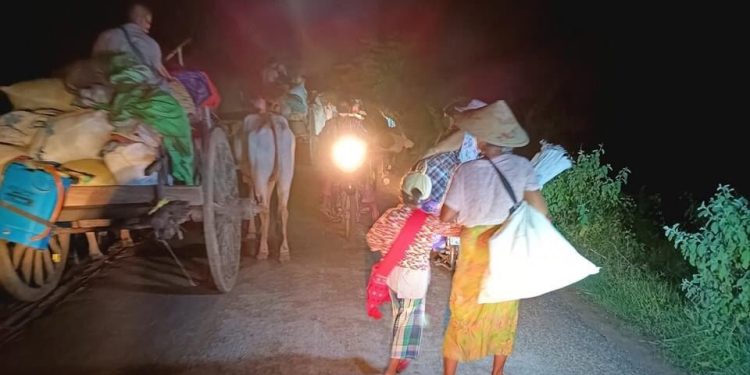India sells weapons to Myanmar’s military regime, but in Manipur, authorities want to keep refugees out
According to the UN, India is the fourth-largest supplier of weapons to Myanmar’s military junta, but in the north-eastern state of Manipur, it wants to add a fence on the border to prevent the influx of people from its neighbour, which according to the local government is fuelling weapons and drugs smuggling. In fact, the issue has more to do with inter-ethnic tensions in the state. Meanwhile, more airstrikes are reported in Myanmar’s Sagaing Region, forcing thousands to flee.
Yangon (AsiaNews) – As Myanmar’s military junta continues their brutal attacks against resistance forces and civilians, India has announced plans to build a 70-kilometre fence along its border with Myanmar in its north-eastern state of Manipur, which has been rocked by inter-ethnic violence since May.
Human rights groups have pointed out that India has an ambiguous relationship with Myanmar’s ruling military, to whom it sells weapons, concerned that the fence risks blocking thousands of civilians fleeing attacks by the military that seized power in a coup in February 2021 ousting the government led by Aung San Suu Kyi.
Since then, a brutal civil war has broken out pitting the junta-led regular army against anti-coup resistance, which includes a panoply of militias from the country’s different ethnic groups.
Yesterday, in the northern Sagaing Region, at least 10,000 people fled their homes after more than 150 soldiers raided villages in the municipalities of Ye-U and Depayin backed by airstrikes.
Some villages were attacked exactly the same way a year ago, a fact that highlights how certain territories are fought over several times by Myanmar’s military and militias.
The most affected areas continue to be the northern Sagaing Region and the neighbouring western state of Chin, where the population is predominantly Christian.
Only yesterday at least two children, including a five-year-old girl, were killed and seven other civilians, including parents, injured in airstrikes.
“Everyone fled during the night to escape the junta raids," residents told The Irrawaddy today. "The troops left our village this morning. However, we don’t dare go back to the village yet."
Army troops have already surrounded churches, fields and homes with landmines to prevent the return of civilians and weaken support for anti-coup militias.
However, an organisation linked to the Karen Liberation Army (one of the main ethnic militias) recently released a paper in which it claims that the regime is gradually losing control of the other end of the country, in the southeast, a sign of further fragmentation of Myanmar.
While internally displaced people now number around two million people, thousands have found refuge abroad, particularly in Thailand to the east and India in the west.
Since the coup, an estimated 60,000 people have entered the north-eastern Indian states of Mizoram and Manipur. But while the former has welcomed refugees, the latter is turning them away. UN data show that at least 38,200 Myanmar refugees were reported in Mizoram in January, compared to 6,950 in Manipur.
The issue has to do with the ethnic composition of the population of north-eastern India, a region also geographically remote from the rest of the country.
Mizoram is home mainly to ethnic Kuki who are Christian, like the Chin who flee from Myanmar. The situation is reversed in Manipur, where a majority of the population is ethnic Meitei, mostly Hindus (53 per cent of the population).
As local sources have repeatedly explained to AsiaNews, while the conflict that broke out in Manipur on 3 May appears to be inter-ethnic, the main struggle is over services provided by the government.
The sectarian clashes began following a peaceful protest by the Kuki minority against a proposal to include the Meitei in a government programme for India’s scheduled tribes, which provides resources and employment based on quotas for disadvantaged indigenous peoples.
At the same time, for months, Indian authorities have claimed that the influx of refugees from Myanmar has caused a rise in weapons and drug smuggling at the border; for this reason, it wants to prevent the passage of refugees.
Myanmar's Chin militias said they did not want to cause harm and that they helped Indian law enforcement officers arrest some traffickers.
“There is no problem for us with their fence because we are no longer building our refugee camps on the Indian side, but only on the Myanmar side of the border,” said Pu Khaing, a displaced person from Myanmar speaking to Radio Free Asia.
“They [Indian authorities] drove us out, but the smugglers have their own way of crossing the border. Ordinary refugees don’t get involved with them,” he added.
According to a report by the UN Special Rapporteur for Myanmar, Tom Andrews, released last May, India is the fourth-largest weapons supplier to Myanmar’s military regime after Russia, China and Singapore, but New Delhi does not seem to be interested in dealing with the consequences of its trade.
19/01/2024 18:33
10/11/2023 18:22
12/02/2024 17:16
13/10/2022 14:26
24/11/2023 19:07







.png)










